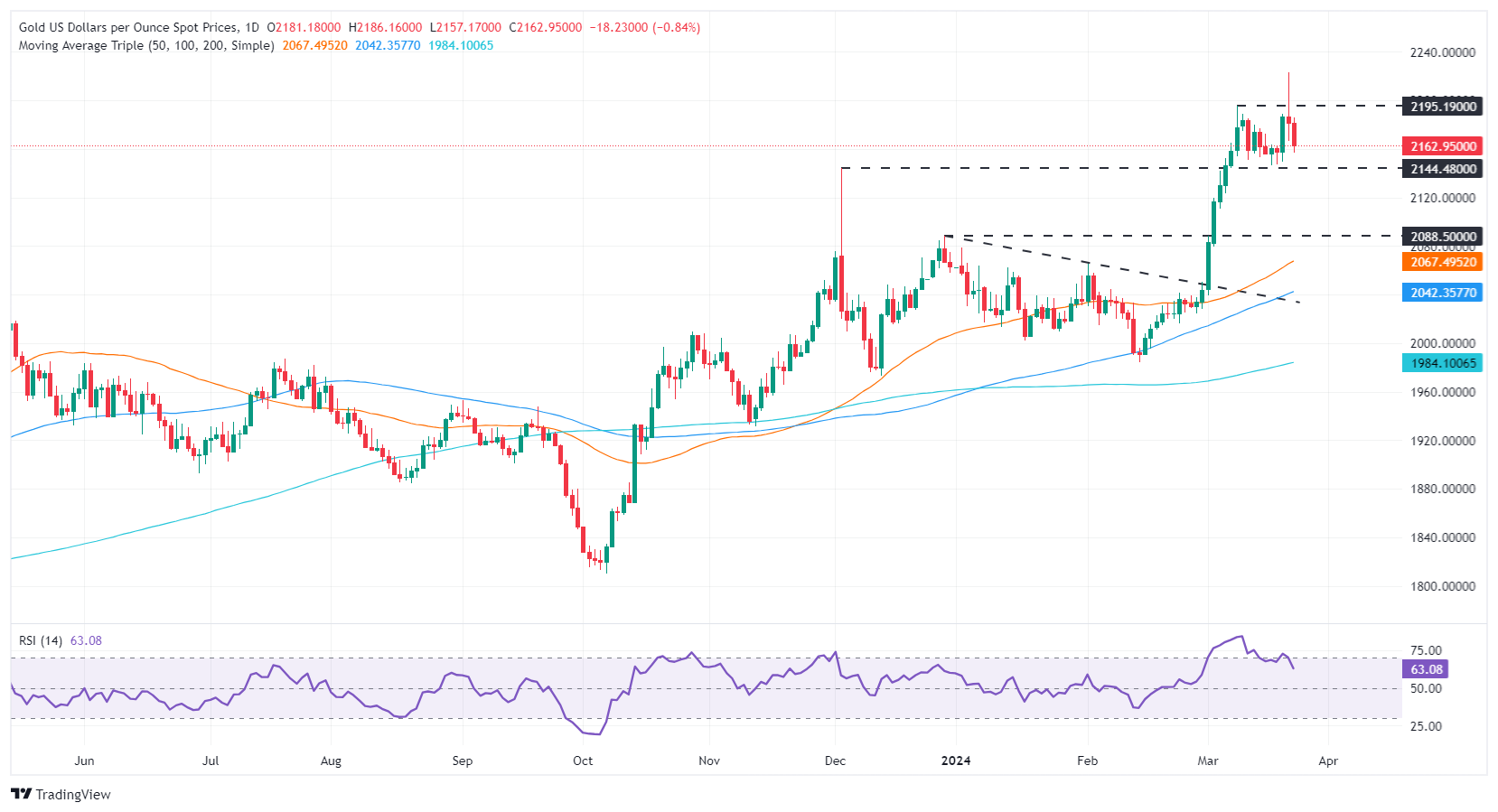- Gold prices are on their second day of decline and fall to $2,159, after reaching an all-time high of $2,223.
- The Federal Reserve's dovish stance on interest rates keeps yields lower in the US, except for the Dollar.
- The odds of the Fed cutting rates in June remain above 70%, according to CME's FedWatch tool.
Gold prices fell for the second day in a row on Friday after reaching an all-time high of $2,223 on Thursday. Renewed demand for the dollar amid falling US Treasury yields surprised traders and weighed on the yellow metal. At the time of writing, the XAU/USD pair is trading at $2.159, losing 0.90%.
The Federal Reserve's March meeting emphasized the need for policymakers to lower interest rates even though the latest two inflation reports suggest it is reaccelerating. This sponsored the rise of XAU/USD to new all-time highs, but it was short-lived.
On Thursday, traders took profits, leading to a decline of $36, and the yellow metal ended the day with losses of 0.22%.
US Treasury yields failed to rise despite the fact that the Dollar has been rising for two days. It gained 0.47% to 104.45 late in the North American session on Friday. The lack of economic data on the calendar has kept markets slightly calm heading into the weekend.
Daily Market Summary: Gold Price Down Despite Falling US Yields
- Jerome Powell stressed that the Fed had made progress in taming inflation. Despite two consecutive months of price increases, this has not changed the Fed's outlook for price stability.
- Fed policymakers kept the Dot Plot for 2024 unchanged. However, the dot plot for 2025 was revised upward, from 3.6% to 3.9%.
- For 2024, the Federal Open Market Committee (FOMC) expects the economy to grow 2.1%, up from 1.4%, while the unemployment rate will remain at 4%.
- Inflation figures in the United States, measured by the Fed's favorite indicator, Personal Consumption Expenditure (PCE), are now in the spotlight. They are expected to be 2.4%, while the core PCE is projected at 2.6%, up from 2.4%.
- During the week of March 18-22, the US schedule revealed that the labor market is strong. However, the economy faces challenges such as the slowdown revealed by the S&P Global PMI data. However, the housing market has recovered slightly, with housing starts, building permits and sales of existing homes improving.
- According to CME's FedWatch tool, expectations for a rate cut in June stand at 75%.
Technical Analysis: Failure of Gold Traders at $2,200 Exposes the $2,180 Level

From a technical point of view, XAU/USD is consolidating above $2,150, hovering around that area for the last eleven days. However, if sellers intervene, dragging Gold prices below the aforementioned barrier, a decline towards the December 28 high-turned-support at $2,088 is on the cards. However, on its way down, key support levels must be broken, such as the December 4 high, which became support at $2,146, before challenging the $2,100 level.
On the other hand, if buyers push prices towards $2,200, the current all-time high at $2,223 will be reached, before aiming towards $2,250.
Frequently asked questions about Gold
Why invest in Gold?
Gold has played a fundamental role in human history, as it has been widely used as a store of value and medium of exchange. Today, aside from its brilliance and use for jewelry, the precious metal is considered a safe-haven asset, meaning it is considered a good investment in turbulent times. Gold is also considered a hedge against inflation and currency depreciation, since it does not depend on any specific issuer or government.
Who buys more Gold?
Central banks are the largest holders of Gold. In their aim to support their currencies in turbulent times, central banks tend to diversify their reserves and purchase Gold to improve the perception of strength of the economy and currency. High Gold reserves can be a source of confidence for the solvency of a country. Central banks added 1,136 tons of gold worth about $70 billion to their reserves in 2022, according to data from the World Gold Council. This is the largest annual purchase since records exist. Central banks in emerging economies such as China, India and Turkey are rapidly increasing their gold reserves.
What correlation does Gold have with other assets?
Gold has an inverse correlation with the US Dollar and US Treasuries, which are the main reserve and safe haven assets. When the Dollar depreciates, the price of Gold tends to rise, allowing investors and central banks to diversify their assets in turbulent times. Gold is also inversely correlated with risk assets. A rally in the stock market tends to weaken the price of Gold, while sell-offs in riskier markets tend to favor the precious metal.
What does the price of Gold depend on?
The price of Gold can move due to a wide range of factors. Geopolitical instability or fear of a deep recession can cause the price of Gold to rise rapidly due to its status as a safe haven asset. As a non-yielding asset, the price of Gold tends to rise when interest rates fall, while rising money prices tend to weigh down the yellow metal. Still, most of the moves depend on how the US Dollar (USD) performs, as the asset is traded in dollars (XAU/USD). A strong Dollar tends to keep the price of Gold in check, while a weaker Dollar is likely to push up Gold prices.
Source: Fx Street
I am Joshua Winder, a senior-level journalist and editor at World Stock Market. I specialize in covering news related to the stock market and economic trends. With more than 8 years of experience in this field, I have become an expert in financial reporting.







